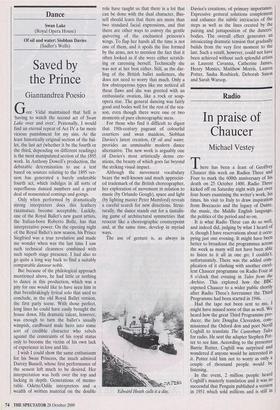Dance
Swan Lake (Royal Opera House)
Saved by the Prince
Giannandrea Poesio
Gore Vidal maintained that hell is `having to watch the second act of Swan Lake over and over'. Personally, I would find an eternal repeat of Act IV a far more vicious punishment for my sins. As the least historically original section of the bal- let, the last act (whether it be the fourth or the third, depending on different readings) is the most manipulated section of the 1895 work. In Anthony Dowell's production, the debatable determination to use a text based on sources relating to the 1895 ver- sion has generated a barely endurable fourth act, which indulges in all sorts of superfluous danced numbers and a great deal of nonsensical comings and goings.
Only when performed by dramatically strong interpreters does this feathery razzmatazz become acceptable. Luckily, one of the Royal Ballet's new guest artists, the Italian-born Roberto Bone, has that interpretative power. On the opening night of the Royal Ballet's new season, his Prince Siegfried was a true revelation and made me wonder when was the last time I saw such technical cleanness combined with such superb stage presence. I had also to go quite a long way back to find a suitably comparable danseur noble.
But because of the philological approach mentioned above, he had little or nothing to dance in this production, which was a pity for one would like to have seen him in that breathtakingly lyrical solo that used to conclude, in the old Royal Ballet version, the first party scene. With those perfect, long lines he could have easily brought the house down. His dramatic talent, however, was enough to turn the ballet's usually wimpish, cardboard male hero into some sort of credible character who rebels against the constraints of his royal status only to become the victim of his own lack of experience in love and life.
I wish I could show the same enthusiasm for his Swan Princess, the much admired Darcey Bussell, whose first performance of the season left much to be desired. Her interpretation was both over the top and lacking in depth. Generations of memo- rable Odette/Odile interpreters and a wealth of written material on the double role have taught us that there is a lot that can be done with the dual character. Bus- sell should learn that there are more than two standard facial expressions, and that there are other ways to convey the gentle quivering of the enchanted princess's wings. To flap her hands all the time is not one of them, and it spoils the line formed by the arms, not to mention the fact that it often looked as if she were either scratch- ing or caressing herself. Technically she was not at her best either. Still, as the dar- ling of the British ballet audiences, she does not need to worry that much. Only a few obstreperous types like me noticed all these flaws and she was greeted with an enthusiastic ovation, like a rock or soap- opera star. The general dancing was fairly good and bodes well for the rest of the sea- son, even though there were one or two moments of pure choreographic mess.
For those who find it difficult to digest that 19th-century pageant of colourful courtiers and swan maidens, Siobhan Davies's latest creation, Of oil and water, provides an unmissable modem dance alternative. The new work is arguably one of Davies's most artistically dense cre- ations, the beauty of which goes far beyond the striking visual impact.
Although the movement vocabulary bears the well-known and much appreciat- ed trademark of the British choreographer, her exploration of movement in relation to music (by Orlando Gough), space and light (by lighting master Peter Mumford) reveals a careful search for new directions. Struc- turally, the dance stands out for a tantalis- ing game of architectural symmetries that reoccur like a choreographic counterpoint and, at the same time, develop in myriad ways.
The use of gesture is, as always in Edward Heath calls it a day. Davies's creations, of primary importance. Expressive gestural solutions complement and enhance the subtle intricacies of the steps as well as the lines created by the pairing and juxtaposition of the dancers' bodies. The overall effect generates an intoxicating dramatic tension that gradually builds from the very first moment to the last. Such a result, however, could not have been achieved without such splendid artists as Laurent Cavanna, Catherine James, Henry Montes, Matthew Morris, Lauren Potter, Sasha Roubicek, Deborah Saxon and Sarah Warsop.


























































































 Previous page
Previous page